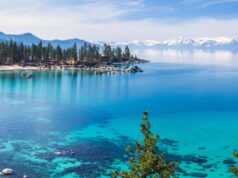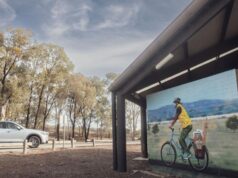Published in Wilderness Magazine, February 2016
Call it the long axis to glory. A traverse of an entire range is more than just a tramp; it’s a novel. It tells its story through time, place and character.
Even if the setting is familiar, a traverse takes you to a place you’ve never been before. The word itself is endowed with power. It’s a true mountaineering word, like crevasse. It sounds cold, tough, in need of considered prepartion. It evokes epic journeys, tales of tears, blood, torment and maybe a touch of elation. To have traversed is to have lived.
Crossings get the guide book write-ups. A couple of days swimming against a rip and hauling yourself out. But a traverse is like being adrift in an ocean, floating with the current, taking whatever comes your way. A loop track is great for convenience and transport, but the reality is you’re walking in a circle, taming the bush, making it conform to your rules. A traverse though is a gloves-off fair fight. There’s no hiding. Whatever is in your way must be dealt with. The most famous traverse currently goes by the name of the Te Araroa Trail. By all means go hard. But traverses should also be personal. It sometimes pays to go over old ground.
Every tramper has a connection to a particular area. We might shop round and try on other outfits, but we’ll keep returning to the one store, usually because it’s close to home and the garments fit us well. For Wellington trampers it’s the Tararuas. The traditional north-south Tararua traverse is nicknamed the S-K. The ‘S’ refers to the Schormann road end (now called the Putara road end), and the ‘K’ is Kaitoke. Everything in between is the Tararuas. The challenge for mountain runners is to complete the traverse in a weekend, with the holy grail of accomplishments being a sub 24-hour time, leaving on Friday evening and making it back in time for work on Monday morning. More normal people myself will prefer to do it in 4 – 7 days, with at least one leg on the ground at all times.
‘Normal people’ includes me, at least in this respect. A Tararua traverse keeps nagging away at me. It’s about joining the dots. All over that wet, lumpy range are peaks, huts, tracks and rivers that I’ve climbed and cursed, spots where I’ve soaked and sunbathed, slept in and fallen off. It makes sense to string them all together at least once, to trace a path through the entire range in one go. Many verses make a traverse.
There are a few options in the Tararuas. I would stick east and tackle Tarn Ridge, maybe make a detour to Mitre Peak, the highest point, then plunge south past the Three Kings, Broken Axe Pinnacles, over Mount Holdsworth and down to Totara Flats, before picking up the Tauherenikau River and sloshing out at Kaitoke.
A route like this for me is like paying tribute to former adversaries, or perhaps revisiting a battleground. In a place like the Tararuas nowhere is ever the same twice. Each time I’ve been to Arete Hut has been different and quite remarkable. The first time was in February, 1992. I was 12 and we were attempting the Northern Crossing. The previous day was a hot, slog up the Oahu River and the steep Yeates 500 track under a baking sun. We dried our boots on Te Matawai’s deck and wore ridiculous, non-tramping clothes. The next morning we woke to an astounding sight. A cold front had whipped in while we slept and thrown snow everywhere, giving us winter in summer. We were bound for Tarn Ridge Hut but progress was slow and the weather worsened. At Arete peak we decided to make for the nearby biv, down on a sheltered bench. Four of us top and tailed the night away in the little two bunk biv as the storm menaced our little house, threatening to smash it to pieces. I loved every moment.
The second time I visited was solo. A new hut had been built, but the character of the old was retained. I was in the best shape of my life, but in the middle of the night I came down suddenly with the flu. I could hardly lift my head the next day but somehow managed to drag myself back to Levin. I had to. I hated every moment.
Then there’s Tarn Ridge Hut. I went there with my uncle last April. He was not far off his 60th birthday and had been my top and had been my top and tail partner at Arete Biv back in 1992. A sun-worshipper like me, he bemoaned the positioning of Tarn Ridge Hut, on the wrong side of the ridge for the afternoon sun. So we dragged our bed rolls to the tussock on the western edge instead, and watched the sinking sun collapse into the Tasman Sea and paint our faces gold as we shared a can of beer.
My traverse would then take me up Girdlestone. From this peak I could make a return to Mitre Peak, the highest peak in the range. On that eventful Northern Crossing we climbed this peak in classic Tararua clag and a freezing wind. On summiting we decided to change into our togs for a ‘summer’ photo, dancing in the snow and mist. I’ve searched for the photo but can’t find it. I now wonder if it really happened, or if it was just a silly idea we had. In a way it doesn’t matter; the memory of it still makes me smile.
Broken Axe Pinnacles must be included in my traverse. The spot where a fall caused the catalyst for the famous ‘Sutch Search.’ The most difficult and dangerous scramble in the Tararuas. I’ve only done them once and it was a cloudless, windless day. The Tararuas can do that sometimes. We went straight over the top, packs and all. I could tramp for the rest of my life and never get another day like that. So here’s hoping when I do my traverse the pinnacles put up a bit of a fight. Just for variety’s sake.
The Jumbo to Holdworth ridge is the only place where I’ve ever cried on a tramp. I can’t remember how old I was but I remember the depth of the snow, up to my little thighs. I remember the horizontal rain and ice ripping at my face. I remember the wetness of everything, the cold and the distinct lack of enjoyment, not surprising given the circumstances. I liked adventure but this was too much; even a precocious kid has his limits. At this time you’re ready to get off the tops.
Totara Flats is a surprising, delightful place. It’s the most un-Tararuas part of the Tararuas. A stupidly large expanse of long grass and flat land beside the feisty Waiohine River. And just across the other side is my favourite hut, Sayer. Give me a night there on my traverse. Light the fire and sweep out the rat droppings: what perfect decadence.
I’ll end my traverse riverside. An easy track down the lovely Tauherenikau River, past the unlovely Tutuwai Hut, in the deep green beech forest, the rest of the Tararuas behind me, hidden by the bush, but stomped in my memory, done and dusted with snow. The novel completed.



